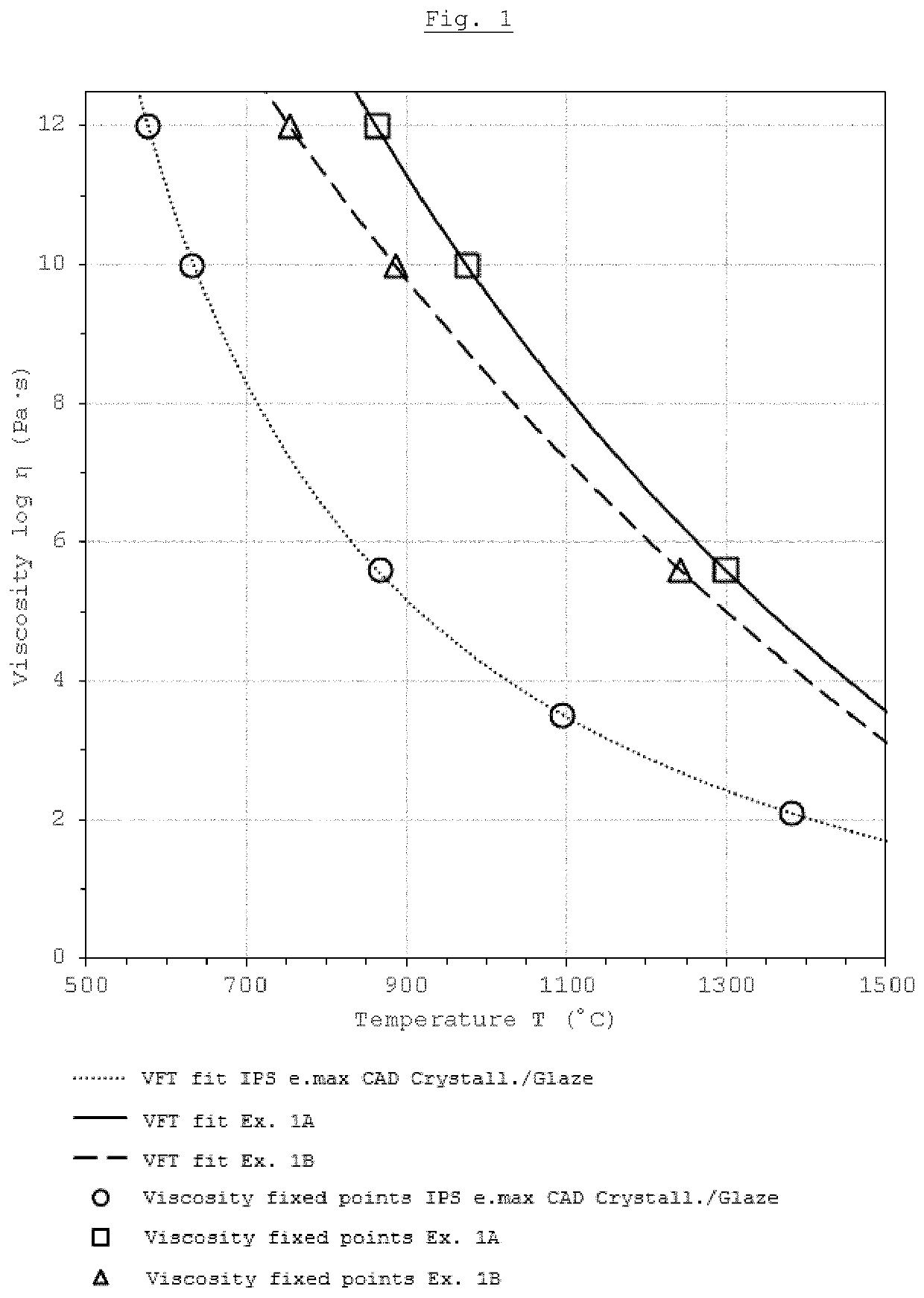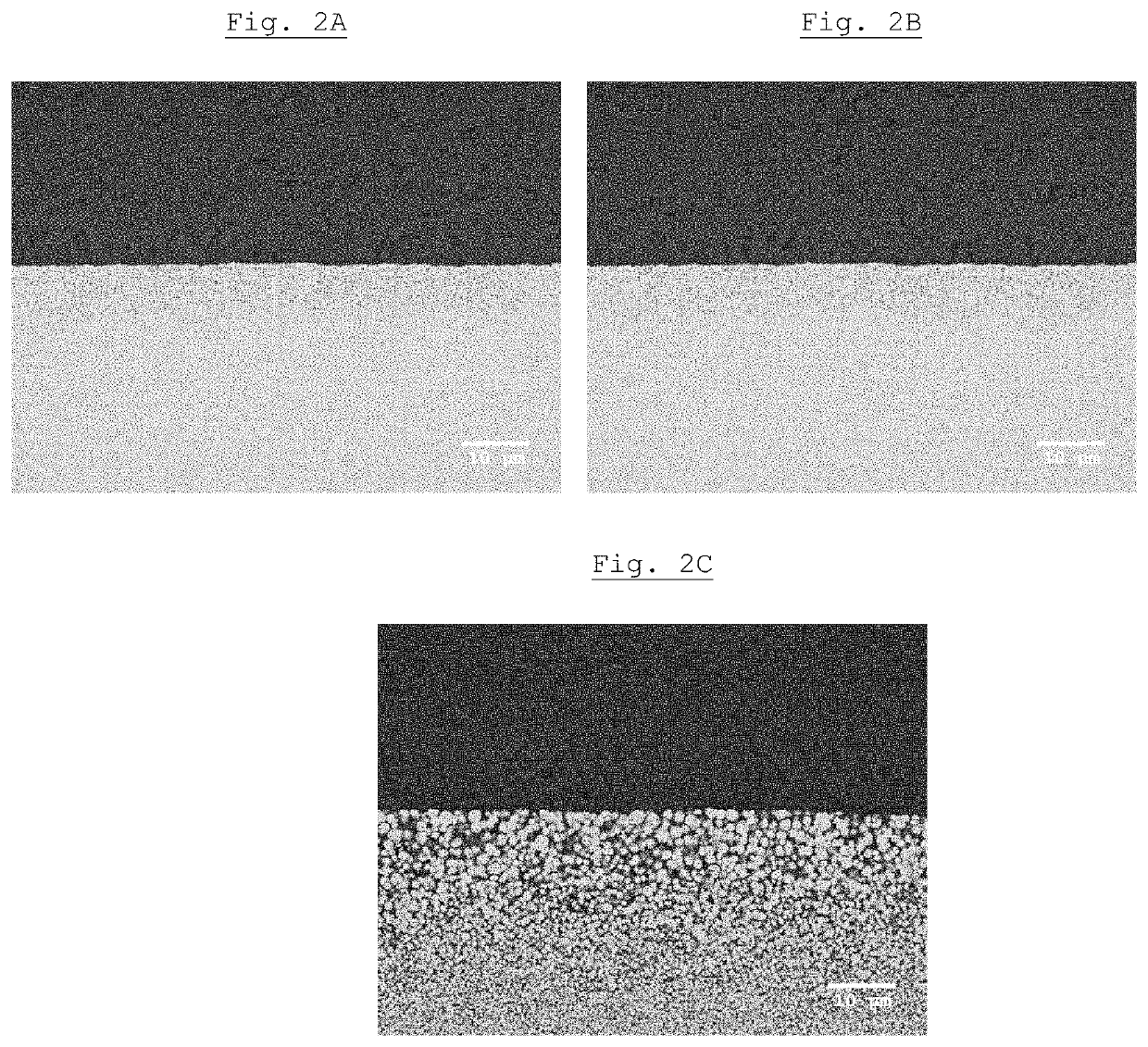Process for producing a glazed ceramic body
a technology of ceramic body and process, which is applied in the direction of artificial teeth, etc., can solve the problems of affecting the optical properties of the restoration, the number of work steps which are usually required for the production of such restorations, and the inability to achieve the effect of reducing the number of process steps, and avoiding the impairment of optical and other physical and chemical properties of the cerami
- Summary
- Abstract
- Description
- Claims
- Application Information
AI Technical Summary
Benefits of technology
Problems solved by technology
Method used
Image
Examples
examples 1a-b
[0058]Preparation of the Glazing Materials
[0059]Two different glasses with the compositions given in Table I were prepared as glazing materials according to the invention.
[0060]
TABLE IExample1A1BComponentwt.-%wt.-%SiO265.4173.39K2O11.6210.25Na2O2.251.98Al2O320.7214.38Total100.00100.00
[0061]For this purpose, first of all 200 g of the raw materials quartz powder (SiO2), potassium carbonate (K2CO3), sodium carbonate (Na2CO3) and aluminium oxyhydroxyhydrate (AlO(OH)×H2O) were thoroughly mixed for 30 min by means of a Turbula mixer.
[0062]From the homogeneous mixtures, cylindrical compacts with a diameter of about 40 mm and weighing about 25 g were produced uniaxially by means of a hydraulic press at a pressure of 3 MPa. These compacts were heated up to 1000° C. in a furnace on a quartz dish over 6 h and held at this temperature for a further 6 h. After cooling in the furnace, the compacts were comminuted by means of a jaw crusher to a size of about 1.5 mm and subsequently ground in a mor...
examples 2a-b
[0065]Determination of the Viscosity Properties of the Glazing Materials
[0066]For the determination of the viscosity properties of the glazing materials obtained in Examples 1A-B as a function of the temperature, a viscosity-temperature curve was calculated on the basis of the Vogel-Furcher-Tammann equation (VFT equation):
[0067]log10(η)=A+BT-T0[0068]η: dynamic viscosity at the temperature T[0069]A, B, T0: substance-specific constants
[0070]For this purpose, at least three of the following characteristic temperatures were determined experimentally by means of a dilatometer or a heating microscope, respectively:
[0071]
Designation and measurement methodη (Pa · s)Tg (glass transition point from dilatometer)12Td (softening temperature from dilatometer)10TS (softening point from heating microscope)5.6THB (hemisphere point from heating microscope)3.5TF (flow point from heating microscope)2.1
[0072]The temperatures Tg and Td were determined by means of a dilatometer (Bahr-Thermoanalyse GmbH)...
examples 3a-b
[0076]Use of the glazing materials for glazing
[0077]Small plates (19 mm×15.4 mm×1.5 mm) were cut from commercially available blanks made of presintered ZrO2 (IPS e.max ZirCAD MO 0, Ivoclar Vivadent AG) and these were used without further thermal pretreatment as substrate material. By means of an airbrushing method using a spray gun (VITA SPRAY-ON, Vita Zahnfabrik) at a working pressure of about 1 bar and from a distance of about 10 cm, aqueous suspensions of the glazing materials A and B prepared in Examples 1A-B were sprayed onto these small plates and, after drying in air for 30 min in a furnace (Sintramat S1 1600, Ivoclar Vivadent AG, program P1), densely sintered within 70 min and simultaneously glazed.
[0078]After the sintering, the glazed small ZrO2 plates were embedded in a two-component resin (EpoKwick Epoxy Resin / EpoKwick Epoxy Hardener 10:2, Buehler), polished at the boundary surface to optical quality (Apex Diamond Grinding Discs, Buehler, grain size to 0.5 μm) and subsequ...
PUM
| Property | Measurement | Unit |
|---|---|---|
| viscosity | aaaaa | aaaaa |
| viscosity | aaaaa | aaaaa |
| viscosity | aaaaa | aaaaa |
Abstract
Description
Claims
Application Information
 Login to View More
Login to View More - R&D
- Intellectual Property
- Life Sciences
- Materials
- Tech Scout
- Unparalleled Data Quality
- Higher Quality Content
- 60% Fewer Hallucinations
Browse by: Latest US Patents, China's latest patents, Technical Efficacy Thesaurus, Application Domain, Technology Topic, Popular Technical Reports.
© 2025 PatSnap. All rights reserved.Legal|Privacy policy|Modern Slavery Act Transparency Statement|Sitemap|About US| Contact US: help@patsnap.com



